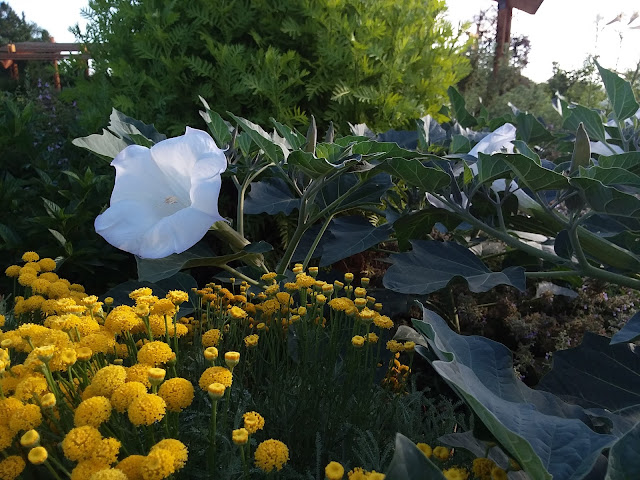What’s Blooming: Theme Gardens
by Andrew Scott, Seasonal Gardener, Gardens on Spring Creek
We are well into summer now, and our gardens have been using their flowers to advertise to pollinators: “Nectar here, inquire within! Reproduction, whoooo!!” In spite of the recent onslaught of sweltering
temperatures, all of our gardens are doing well – constantly changing as
different plants cycle through vegetative growth, blooming, fruiting and going
to seed. While all our gardens are based around specific themes, our Theme
Gardens are a more specific collection of native and cultivated plants. Composed of five gardens, the Theme Gardens are
each small enough to be cohesive on its own, but effortlessly blend together to
form a collage of colors, heights, textures, scents and pollinators.
Plant Select is the first garden one encounters after
crossing over the bridge, flanking visitors on both sides of the walkway with displays
of Plant Select® plantings. Species in
this collaboration of Colorado State University, Denver Botanic Gardens and
contributing horticulturalists are chosen to create gardens that are both
beautiful and resilient to the unique climatic challenges that Front Range
plants endure. Sure, you could visit Plant
Select’s website to see what they recommend, or you could get out of
the house and meander through the gravel paths to see how these hardy plants
would look up close in your own garden!
 |
Chocolate flower (Berlandiera lyrata) in the Plant Select® Garden
This garden actually helped me discover one of my new
favorite plants: chocolate flower (Berlandiera lyrata). Not only is it a
pollinator favorite that can thrive in the heat, but it also enjoys our salty
and basic soils, can withstand winter temperatures in excess of 20 degrees
below freezing, only needs a foot of moisture a year... and it smells like
chocolate chip cookies. Guys. A plant that smells like cookies! As if we needed more proof of how cool plants
are!
With a plant that aromatic, it naturally transitions into
the Fragrance Garden, meant to showcase the odoriferous and volatile organic
compounds that plants can produce. Raised beds were specifically included in
this garden to increase accessibility for all visitors, helping everyone to get
their nose in a flower. Immediately upon entering the garden, or even just
walking by it, you can expect to experience a deluge of intermingling scents:
the fresh and cucumber-like aroma from garden phlox (Phlox paniculata),
the slightly sweet florality of sacred datura (Datura wrightii), the
minty camphor of the leaves of green wormwood (Artemisia viridis), the
unmistakable sulphureous notes of common garden chives (Allium schoenoprasum)
and so many more!
 |
Sacred datura (Datura wrightii, upper) and brassbuttons (Cotula spp., lower) in the Fragrance Garden
The Fragrance Garden shifts into a botanical garden classic, the Rose Garden, displaying the seemingly endless cultivars of Rosa, including classic hybrid teas, grandifloras, floribundas and miniature types. Every color of rose imaginable can be found here, ranging from stark white through sunset oranges, playful and vibrant pinks and exemplary deep reds, complemented by several other species of native forbs, grasses, and vines. Benches and shade structures are spread throughout the Fragrance and Rose Gardens so you can take classy pictures with the family, sit and catch up with friends or simply take a moment to ground yourself in this crazy world. The Moon Garden is the last part of this collection of gardens. Just based on the name, I had originally thought it was a garden comprised of species hardy enough to live in outer space and help us beautify human space colonies... but alas, this garden is slightly more down to earth, exhibiting species that look the most stunning in low light or attract nighttime pollinators like moths and bats. Here you can expect to find more roses and sacred datura, as well as plants like white diamond sedum (Sedum pachyclados), false white indigo (Baptisia alba var. macrophylla) already showing its bulbous fruits, the alien-looking succulent iceplant (Delopsperma congestum) and moon carrot (Seseli gummiferum)… are we actually sure this garden didn’t come from outer space...?
|
The final theme garden is detached from the previous four,
located down the main path just before the Foothills Garden. The Hummingbird
& Butterfly Garden was designed to be especially attractive to hummingbirds
and butterflies, not just for food but shelter as well. The garden is cut in
half by a paved path, allowing one to walk the garden and experience it from
all angles. Here one will find coneflowers (Echinacea spp.), rough
goldenrods (Solidago rugosa), ornamental onions (Allium stipitatum),
baby’s breath (Gypsophila paniculata) and native grasses like prairie
dropseed (Sporobolus heterolepis). Few people realize the impact that
our native grasses can have on pollinator wellbeing, so our horticulturists
emphasize their placement within arrangements whenever possible!
 |
A taxiles skipper (Poanes taxiles)
on a coneflower in the Hummingbird & Butterfly Garden
Whether you’re looking for hardy plants for your own garden, a sensory experience that goes beyond simply sight, a picturesque and classic garden to take in while taking the weight off your feet, a seemingly extraterrestrial plantscape or perceiving potential pollinators, the Theme Gardens offer a wide range of species to keep any visitor engaged!
